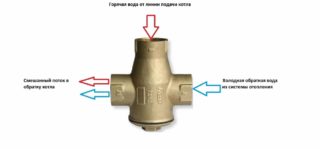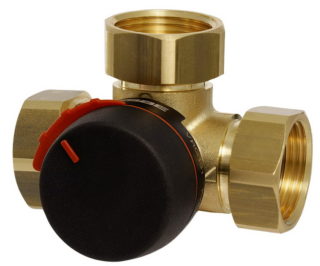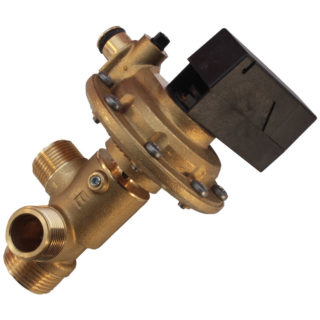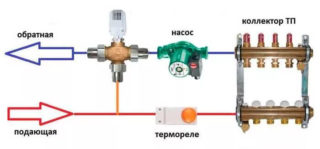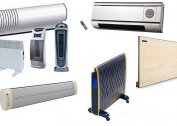The thermostatic three-way valve for the boiler, installed in an autonomous heating system, allows you to save fuel, increase the life of the equipment, protecting from malfunctions. It plays the role of regulator and safety element. But it is impossible to install the first heat mixer into the system; you must select a device that matches its characteristics and the requirements for functionality regarding it.
The device and principle of operation of the three-way valve for the boiler
The design of the heat-mixing valve for a solid fuel boiler or another may differ significantly depending on the purpose of the element and the manufacturer, but the principle of operation remains unchanged. The temperature controller has three outputs: one of them is always open, and the others overlap completely or partially during operation. By the number of outputs, the valve is called a 3-way valve. It is used to mix or separate the flow of liquid or gas, whereby the temperature of the coolant is adjusted, switching from one circuit to another.
It looks like a tee in appearance. The internal device is represented by a locking mechanism and a rod that provides its movement - these are the main elements. Some designs have two seat rings that lock the bolt. Perhaps the addition of other elements.
Types of valves
The functionality of the valves is different. According to this feature, three-way valves are divided into switching, mixing and separation.
Mixing
A cold stream is supplied to one entrance, and a hot stream to another. At the exit, they mix, forming one stream of a given temperature. Thus, thanks to the heat mixer, the temperature of the coolant is regulated, in particular, the return is mixed into the coolant at the outlet of the boiler. For this, the valve is installed on the return pipe of the heating pipe.
Dividing
Dividing valves are also called distribution valves. They split one stream into two. They are used in hot water supply systems, air heater piping.
Switching
Switching or changeover switches from circuit to circuit, for example, from heating to hot water supply. Switching is carried out using an electric drive.
Three-way valve control methods
Three-way valves according to the control method are:
- autonomous;
- tame;
- Thermostatic
- with electric drive.
If there is no control capability, the thermal valve is an autonomous type. It is set by the manufacturer to a specific coolant temperature, i.e. the temperature in the system will be constant always. The main advantages of such devices are low cost and the ability to maintain the same temperature. But it is impossible to change the preset settings, therefore, the characteristics of the valve must comply with the requirements of the system;
The three-way valve with manual control is equipped with a manual adjustment device, which is the control panel, rotary knob or valve. Control of adjustment is carried out using special marks - scales. Compared with an autonomous controller, the three-way manual thermal valve is more functional: it allows you to change the temperature regime depending on specific needs and will maintain the temperature at a given level. However, this valve “does not know how” to react by changing the temperature of the coolant to the transformation of environmental conditions.
The design of the product with a thermostat provides a thermostat. The gas or liquid medium inside it reacts to a change in the temperature of the coolant. When it is heated to a preset temperature, the hot-coolant pipe is blocked. By type of supply, this type of valve can be mechanical and electronic. The mechanical ones work autonomously, while the electronic ones require the presence of an electric network or periodic replacement of batteries. Although this inconvenience is fully offset by the benefits.
The inclusion of a thermostatic valve for a solid fuel boiler in the system allows you to automate the process of changing the temperature regime according to the time of day, days of the week. The cost of a three-way element with a temperature controller is higher than the cost of simpler analogues.
The most advanced models are electric thermal valves. In order for their work to be constant, it is necessary to install an uninterruptible power supply unit. The flow of cold or hot coolant is regulated using a controller that registers temperature deviations from the set values, and a servo drive. The outputs do not completely overlap, but the volume of the coolant changes. Thanks to the operation of the automation, the heating circuit is always uniformly heated, and the temperature of the coolant always exactly matches the set temperature. The possibility of changing the mode is also present, but you need to be prepared for a high consumption of resources: coolant and electricity. You will have to pay more for the thermal valve itself. A fully automatic device is more expensive.
Purpose and functions
A three-way valve is installed for such purposes:
- In order for the coolant not to succumb to the boiler and not to cause condensation on the inner walls of the furnace. In addition, if a cast-iron heat exchanger is used in the boiler, it can crack from a temperature difference.
- To regulate the temperature of the coolant in the circuits. This need may be due to the complexity of the system, where the temperature requirements for each circuit are different. When connected to a heat accumulator, as well as when the coolant is used in the heat exchanger of the ventilation air supply unit, which is part of the air heating system.
- To be able to control the heating of the coolant in the floor heating circuit. The optimum temperature for a warm floor is no more than 50 ° C. The temperature of the coolant coming from the boiler can exceed this indicator by 10-35 ° C. The cooled water passing through the underfloor heating circuit will be mixed with the heat carrier from the boiler, a three-way valve installed on the distribution manifold will ensure the return is mixed.
The regulator should not be installed if several sources of heating are working alternately in the system; if the length of each loop of the water floor is not more than 50-60 m (then instead of a three-way valve, RTL heads are installed); if the heating is organized by gravity.
The main parameters when choosing valves
The three-way valve should match the features of the system as much as possible, therefore, when choosing, you should check all the parameters: design device, technical specifications.
- First of all, it is necessary to cut off options that are made of inappropriate metal.Siluminic inexpensive three-way valves immediately exclude, since the alloy of aluminum with silicon is characterized by low strength. Such thermal valves crack and literally crumble during operation.
- Cast iron 3-way valves are not subject to corrosion and are strong enough under static loads, but a point mechanical impact or a sharp temperature drop can cause it to break. Such devices cannot be repaired.
- Steel devices are inexpensive and durable, but rust over time. In order to protect against corrosion, the products are coated with nickel and chrome.
- Stainless steel thermal valves are more expensive, metal is not susceptible to oxidation and corrosion, so they will last a long time.
- Brass and bronze three-way valves are preferable, since the material best meets the requirements for service life and corrosion. Brass products cannot be installed in a system where the coolant is heated to temperatures exceeding 200 degrees. Bronze devices are embedded in a heating circuit made of copper.
The internal locking mechanism in some products may be ceramic. Under observance of operating conditions, ceramics behaves in the best way: it does not rust and lasts a long time. But the coolant in the system must be of high quality. In the presence of mechanical impurities, ceramic elements will quickly fail.
The type of valve is selected taking into account the features of the system:
- To protect the boiler from condensation, a valve with an internal thermostat set to a constant coolant temperature is sufficient.
- If the system consists of several branches and it is necessary to control the heating of each, install a controller with a thermal head and an external sensor.
- For self-assembly of the system, a mixing valve is recommended for installation. It is easier for a beginner to understand the scheme of his work, how to put it, remove it.
- Saddle varieties, unlike rotary ones, more accurately allow you to adjust the temperature of the coolant and pressure.
- For underfloor heating, electric models with a servo drive are recommended.
- For domestic hot water - isolation valves, for heating - mixing valves.
With regard to technical characteristics, it is necessary to take into account:
- connection method - it is threaded and flanged;
- inner diameter of pipes - must coincide with the diameter of the pipes at the installation site;
- maximum working pressure;
- maximum coolant temperature at the installation site;
- average water flow per hour - conditional throughput;
- dynamic control range (30: 1, 50: 1, 100: 1) - indicates the difference in throughput with a fully closed shutter and half-open.
Valves with a range of 100: 1 show wider adjustment possibilities.
The data is indicated in the passport to the product. In order to correctly select the valve according to the parameters of the system, it is also necessary to calculate the flow rate of the coolant on the installation line, because the valve must pass the right amount of water at different positions of the stem.
Last but not least, the parameter is the manufacturer. Popular:
- Esbe (Sweden);
- Danfoss (Denmark);
- Honeywell (USA);
- Herz Armaturen (Austria);
- Caleffi (Italy);
- Icma (Italy);
- Valtec (Russia).
It is recommended to choose products of well-known brands, then you can be sure that the markings and declared characteristics match the real parameters of the three-way valve.
Simplified Budget Items
Three-way valves of an autonomous type are considered simplified. Their internal structure is really simplified, since neither a thermal head with a controller nor a rod is provided for in them.The thermostatic element is installed inside and is designed for a specific temperature (often 50 ° C or 60 ° C). It is no longer possible to change the settings; the flow temperature at the valve outlet will always correspond to the set ± 2 ° С. This option is for those who install the valve in simple heating systems and want to save. The cost of simplified elements is approximately 30% lower than the average cost of the bulk of regulators.
The thermostatic three-way valve is necessary in complex systems that include several circuits: domestic hot water, heating, underfloor heating. It allows you to save fuel by using the heat generated by the boiler more efficiently. Despite many advantages, the installation of the valve is not always justified, so you should consult a specialist regarding the appropriateness of its installation.

